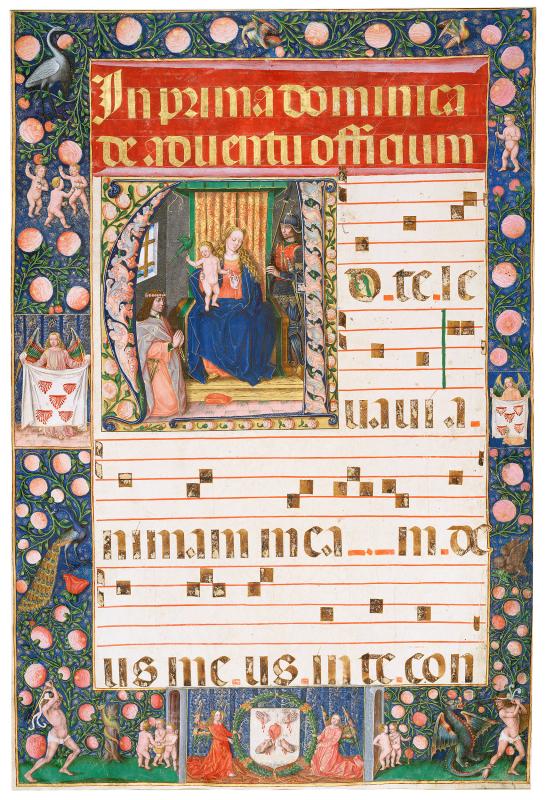
Accession number
MS M.887.1-2
Object title
Gradual single leaves (MS M.887.1-2).
Created
Castile, Spain, ca. 1500-1510.
Credit line
Gift of William S. Glazier, 1958.
Description
2 leaves (1 column, 4-5 lines text, 4-5 four and five-line staves), matted : vellum, ill. ; 928 x 600 mm
Provenance
Perhaps executed for a member of the Acuña family of Castile (Acuña arms, the Five Wounds of Christ, in border decoration of various leaves); Arthur Rau, Paris; gift of William S. Glazier in 1958.
Notes
Ms. gradual single leaves written and illuminated in Castile, Spain, ca. 1500-1510.
Decoration: M.887.1: 1 historiated initial A containing the Miracle of the Gentleman of Cologne, full border decoration with historiated vignettes.
Decoration: M.887.2: 1 historiated initial R containing the Resurrection, full border decoration with historiated vignettes.
Musical notation: 4-5-line red staves with square notes
9 leaves were offered by Arthur Rau of Paris in 1958; a 10th appeared subsequently: 1. (Initial A) Miracle of the Gentleman of Cologne [PML M.887.1] 2. (Initial R) Resurrection [PML M.887.2] 3. (Initial S) Pentecost [Strouse Collection] 4. (Initial I) Miracle of the Gentleman of Cologne [formerly Strouse, now Getty] 5. (Initial P) Nativity [Detroit Public Library] 6. (Initial R) Expulsion from the Temple [Detroit Public Library] 7. (Initial A) Ascension/Resurrection [Detroit Public Library] 8. (Initial N) Miracle of the Gentleman of Cologne [Detroit Public Library] 9. (Initial Q) Miracle of the Gentleman of Cologne [Sotheby's leaf - to Yale?] 10. (Initial S) Miracle of the Gentleman of Cologne [Jörn Günther leaf]
Decoration: M.887.1: 1 historiated initial A containing the Miracle of the Gentleman of Cologne, full border decoration with historiated vignettes.
Decoration: M.887.2: 1 historiated initial R containing the Resurrection, full border decoration with historiated vignettes.
Musical notation: 4-5-line red staves with square notes
9 leaves were offered by Arthur Rau of Paris in 1958; a 10th appeared subsequently: 1. (Initial A) Miracle of the Gentleman of Cologne [PML M.887.1] 2. (Initial R) Resurrection [PML M.887.2] 3. (Initial S) Pentecost [Strouse Collection] 4. (Initial I) Miracle of the Gentleman of Cologne [formerly Strouse, now Getty] 5. (Initial P) Nativity [Detroit Public Library] 6. (Initial R) Expulsion from the Temple [Detroit Public Library] 7. (Initial A) Ascension/Resurrection [Detroit Public Library] 8. (Initial N) Miracle of the Gentleman of Cologne [Detroit Public Library] 9. (Initial Q) Miracle of the Gentleman of Cologne [Sotheby's leaf - to Yale?] 10. (Initial S) Miracle of the Gentleman of Cologne [Jörn Günther leaf]
Script
textura
Language
Latin
Resources
Century
Catalog link
Classification
Department
Display Date
ca. 1500-1510.
